1. Like a father, Shrikrushna teaches virtuous conducts
in daily life from the shloka (Verse) ‘Karagre vasate Lakshmi …’
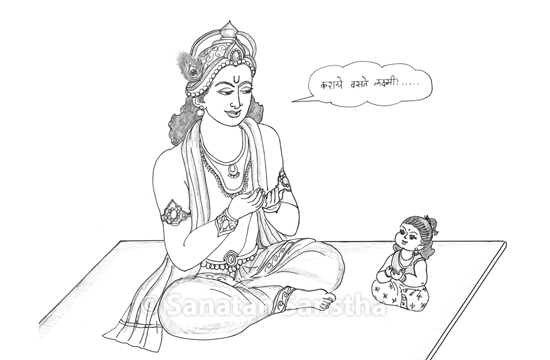
‘On 27.10.2012, I was translating the Holy text ‘Daily conduct and the science underlying its acts’ into Tamil. While understanding the implied meaning of the shloka ‘Karagre vasate Lakshmi …’, my bhav (spiritual emotion) was awakened and I drew the picture given ahead. I perceived that since I was performing the seva of translation, H.H. Dr Athavale (Sanatan’s source of inspiration) gave me a gift in the form of the picture.
A. Implied meaning of the picture
1. ‘Due to Shrikrushna’s blessings, the implied meaning of the picture is imbibed by the subconscious mind
Like a good father, Shrikrushna is teaching me every virtuous conduct in day-to-day life right from the shloka ‘Karagre vasate Lakshmi …’, and due to His blessings, with the shloka its implied meaning is also imbibed by my subconscious mind.
2. For the sake of devotees, God discards His subtlest of the nirgun (Non-materialised) form and manifests in the captivating and easily identifiable sagun (Materialised) form
God is the subtlest. Hence, ignorant individuals will not find Him anywhere. Hiranyakashipu made countless attempts to find Him, but without success; however, Prahlad, the devotee could visualise Him in every animate and non-animate object. The modern Hiranyakashipus of Kaliyug ask, ‘From which college did Prabhu Ramchandra pass engineering to build the Ramsetu; however, for the sake of the devotees who have intense yearning, He resides in their hands. The unique concept that ‘the Creator of the universe is in our hands and He gives us darshan (Vision) whenever we want’ makes us aware of His infinite grace. For the sake of the devotees, God discards His subtlest of the nirgun form and manifests in the captivating and easily identifiable sagun form.
3. Upon having darshan in the cupped hands, God provides the energy to perform the mission of Dharma
God gives us darshan in our cupped hands every morning and saves our time. He, thus, provides us with enough energy and enthusiasm to perform the mission of Dharma.
4. Importance of the attitude of surrender
A. Upon offering doership at the Holy feet of God, He increases our ability beyond our imagination and gets all the tasks done through us
In any science, theory has only 2% importance and practical has 98% importance. Similarly, the Ichha-shakti (Energy of will) and Dnyan-shakti (Energy of knowledge) attain completeness only when they are transformed into Kriya-shakti (Energy of action); because, Kriya-shakti denotes action. In all our actions and activities, the hands have a lion’s share. When we offer doership at the Holy feet of God with attitude of surrender, He increases our functional ability beyond our imagination and gets all the tasks done through us.
B. In the process of surrender, when we offer our hands at the Holy feet of God, our ego reduces.
C. Each karma (Action which gives rise to destiny) performed with an attitude of surrender becomes akarma-karma (An act, action which despite being a karma bestows the benefits of akarma).
5. Cupped hands and the lotus
When we cup our hands, it takes the shape of a lotus and our fingers become the petals of the lotus. This lotus is offered at the Holy feet of God.’
– Mrs Uma Ravichandran, Chennai, Tamil Nadu.
2. Shrikrushna teaching how to perform the puja
(Ritualistic worship) on Shri Ganesh Chaturthi with utmost bhav
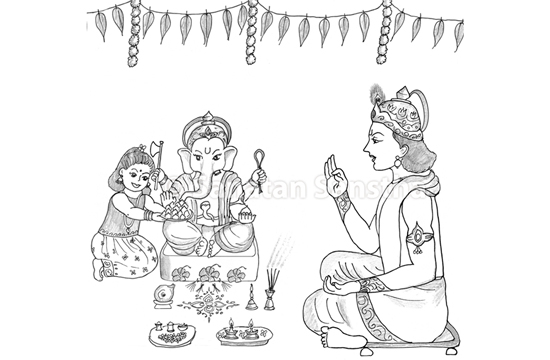
‘Shrikrushna is teaching me how to perform puja on Shri Ganesh Chaturthi with utmost bhav. He has become a priest and I am worshipping as per His guidance. Shri Ganesh is present actually and is consuming the Naivedya offered to Him. I drew this picture exhibiting balakbhav (Childlike emotion) while I was sitting in the meditation room of Sanatan’s Ramnathi Ashram.’ – Mrs Uma Ravichandran, Chennai, Tamil Nadu. (9.9.2012, 8 a.m.)
A. Importance of the place where the picture is drawn
1. When compared with the pictures drawn at other places, manifestation of the Divine beauty through Shrikrushna’s face from a picture drawn by the lady-seeker while sitting in the meditation room is greater, and this is an excellent example of how the brilliance of an individual enhances when pictures are drawn at a Chaitanya (Divine consciousness) -enriched place
Of all the pictures I have drawn so far, Shrikrushna is most beautiful in this picture and I feel His beauty is enriched with Divine radiance. The design on His crown is also more sattvik. Since this picture was drawn in the meditation room, the divinity has manifested on Shrikrushna’s face significantly in a Chaitanya-enriched environment. This highlights the importance of a place.
2. Design of flowers on the ghagara (Traditional Bharatiya skirt) of the lady-seeker exhibiting balakbhav in the picture depicts her happiness upon arriving at Ramnathi Ashram
The increase in Anand of the child-seeker exhibiting balakbhav is evident from the picture. In all earlier pictures, only the border of the ghagara worn by the child-seeker has a design and there is no floral design on the ghagara. There is a lavish spread of Anand-bestowing design of flowers on the ghagara of the child-seeker. In addition to the Divine beauty of Shrikrushna, the ghagara of the lady-seeker exhibiting balakbhav is also very beautiful. In other words, it also manifests Anand. The lady-seeker has expressed the Anand she experienced upon coming to Sanatan’s Ramnathi Ashram through the ghagara she wears in the picture.
3. Picture that highlights the fact that as the spiritual level of a seeker rises, the level of bhav exhibited through the picture inclines towards Chaitanya
While looking at all the pictures, it becomes apparent that as the lady-seeker gets engrossed in the picture at the level of bhav to a progressively greater extent, the subsequent pictures too exhibit progressively increasing Sattva component. Bhav is perceived in her earlier pictures; whereas, Chaitanya and bhav are perceived in the pictures drawn while sitting in the meditation room. This highlights the fact that as the spiritual level of a seeker rises, the level of bhav exhibited through the picture inclines towards Chaitanya.
– H.H. (Mrs.) Anjali Gadgil, Sanatan Ashram, Ramnathi, Goa. (12.9.2012)
3. Shrikrushna shows how the Shakti of a Deity
is active every day depending on the Deity Principle
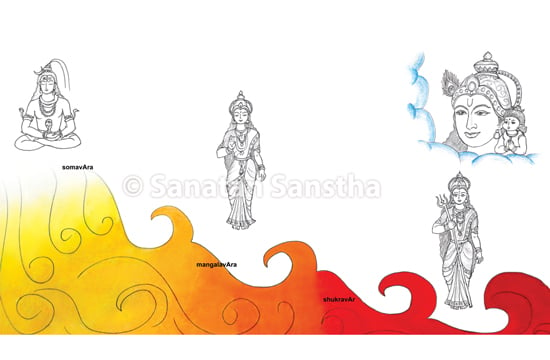 A. Implied meaning of the picture
A. Implied meaning of the pictureInformation on Deities associated with days and the colour of clothes complementary to the Deity’ is provided in Sanatan’s Holy text ‘How should the clothes be from a spiritual perspective ?’ This Holy text explains the change in the colour from nirgun to sagun level as per the days. For example, ‘There is Shivatattva (Principle of Deity Shiva) in the atmosphere on Monday, the flow of nirgun starts in the atmosphere; on Tuesday it transforms into nirgun-sagun and shows tarak-shakti (Saviour energy); in the end this Principle takes on sagun form of marak-shakti (Destroyer energy) on Friday’. Hence, Shrikrushna shows me immediately that the energy flow turns yellow from white, reddish from yellow, red from reddish. In the end, it becomes dark red and takes on the sagun form of marak-shakti. After realising how each day is associated with Spirituality as per God’s planning, my bhav awakened to a great extent.’ – Mrs Uma Ravichandran, Chennai. (30.11.2012, 2.40 p.m.)

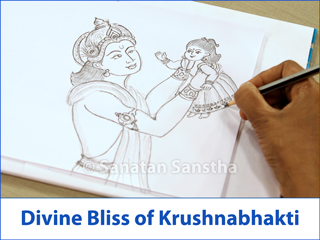 Pictures of Balakbhav bestowing the Divine Bliss of Krushnabhakti
Pictures of Balakbhav bestowing the Divine Bliss of Krushnabhakti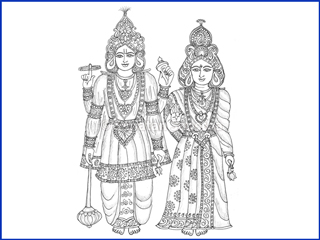 Picture of Shri Lakshminarayan at Jaipur drawn on the day of Ramnavami
Picture of Shri Lakshminarayan at Jaipur drawn on the day of Ramnavami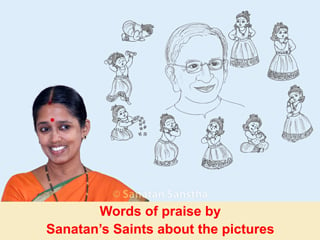 Words of praise by Sanatan’s Saints about the pictures depicting Balakbhav
Words of praise by Sanatan’s Saints about the pictures depicting Balakbhav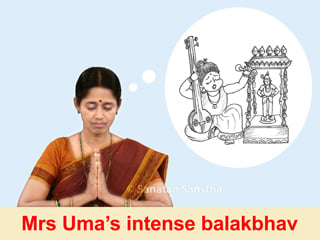 Spiritual experiences of gopis upon seeing the pictures drawn by Mrs Uma
Spiritual experiences of gopis upon seeing the pictures drawn by Mrs Uma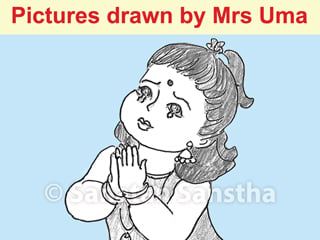 Characteristics perceived by Sanatan’s seeker-artists about pictures drawn by Mrs Uma and associated spiritual experiences
Characteristics perceived by Sanatan’s seeker-artists about pictures drawn by Mrs Uma and associated spiritual experiences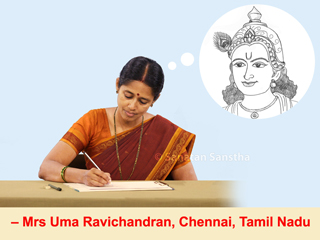 Picture depicting spiritual experience pertaining to H.H. Dr Athavale (Part 2)
Picture depicting spiritual experience pertaining to H.H. Dr Athavale (Part 2)